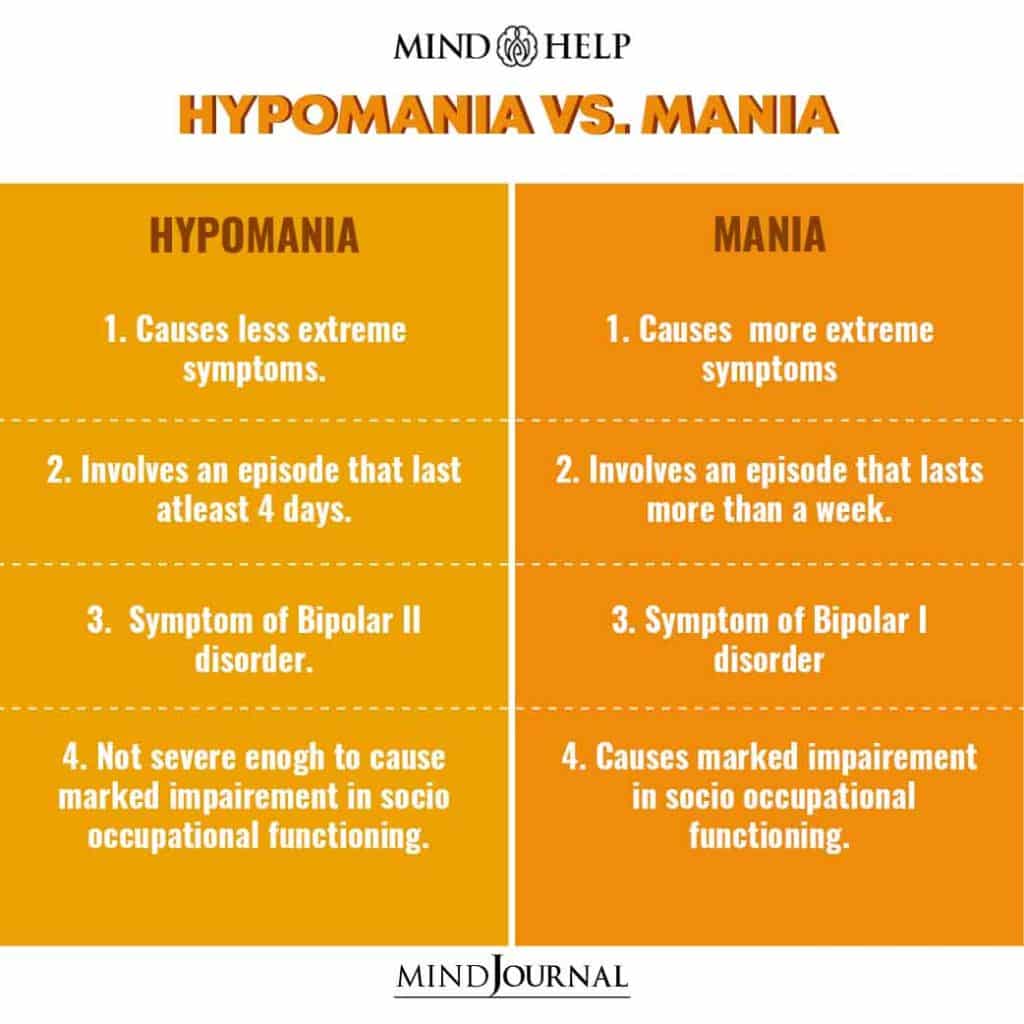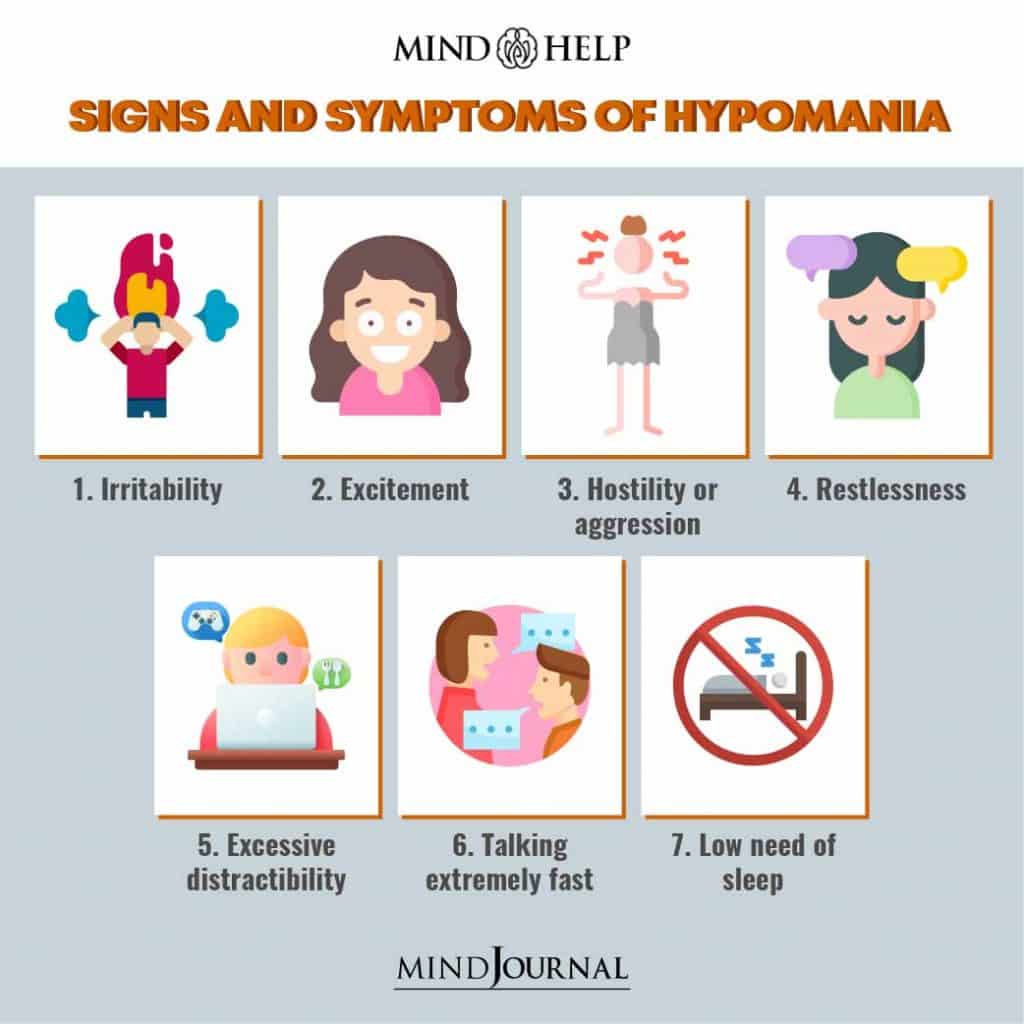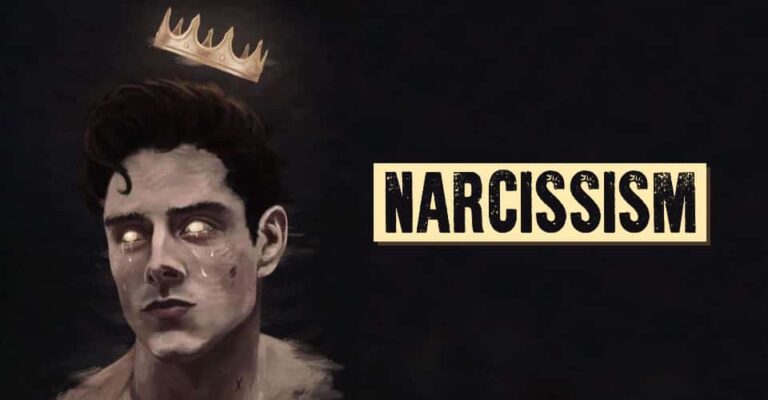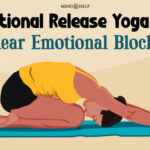Table of Contents
Hypomania is a condition characterized by abnormal euphoria that affects the mood, thoughts, and behavior of the individual. It is also a possible symptom of bipolar disorder, especially type II.
What Is Hypomania?
Hypomania is a mental condition characterized by persistent disinhibition and elated mood that affects the behavior and mood of the individual. According to the Diagnostic and Statistical Manual of Mental Disorders (DSM 5), hypomania is different from mania since there is no significant functional impairment. On the other hand, mania does include significant functional impairment along with psychotic features. A hypomanic episode is evident when the person displays –
- Irritability
- Excitement
- Flamboyance
- Restlessness
- Extreme talkativeness
- Excessive distractibility
- Insomnia
- Extreme focus on a particular activity
Even though hypomanic behavior often displays productivity and excitement, it can become a matter of concern if the individual engages in risky behaviors that can interfere with daily life. A 2006 study 1 National Collaborating Centre for Mental Health (UK). Bipolar Disorder: The Management of Bipolar Disorder in Adults, Children and Adolescents, in Primary and Secondary Care. Leicester (UK): British Psychological Society; 2006. (NICE Clinical Guidelines, No. 38.) 4, BIPOLAR DISORDER AND ITS DIAGNOSIS. Available from: https://www.ncbi.nlm.nih.gov/books/NBK55388/ pointed out that this condition is a feature of bipolar disorder and cyclothymia, but can also occur in schizoaffective disorder. Some individuals with bipolar I disorder have hypomanic as well as manic episodes. It may also occur when the mood progresses downwards from a manic mood to a normal mood.
One 2012 study 2 Johnson, S. L., Murray, G., Fredrickson, B., Youngstrom, E. A., Hinshaw, S., Bass, J. M., Deckersbach, T., Schooler, J., & Salloum, I. (2012). Creativity and bipolar disorder: touched by fire or burning with questions?. Clinical psychology review, 32(1), 1–12. https://doi.org/10.1016/j.cpr.2011.10.001 found that hypomanics are often found to be more creative and energetic. Many people with bipolar disorder have credited hypomania with giving them an edge in their theater work. It is, however, essential to keep in mind that this condition may transition into mania, which may have psychotic symptoms. In this case, the individual may have developed bipolar I disorder. A 2011 study 3 Jansen K, Ores Lda C, Cardoso Tde A, Lima Rda C, Souza LD, Magalhães PV, Pinheiro RT, da Silva RA. Prevalence of episodes of mania and hypomania and associated comorbidities among young adults. J Affect Disord. 2011 Apr;130(1-2):328-33. doi: 10.1016/j.jad.2010.10.007. Epub 2010 Nov 4. PMID: 21055824. estimated the prevalence rate of this condition to be 5.3%. A 2017 study 4 Hosang, G. M., Cardno, A. G., Freeman, D., & Ronald, A. (2017). Characterization and structure of hypomania in a British nonclinical adolescent sample. Journal of affective disorders, 207, 228–235. https://doi.org/10.1016/j.jad.2016.08.033 found that adolescents are at high risk for bipolar disorders.
Read More About Insomnia Here
Hypomania Vs. Mania

Hypomania and mania may share similar symptoms but may differ in the degree of the symptoms experienced. Both the conditions display mood and behavioral changes that are beyond normal. Mania tends to be an extreme degree of hypomania. The symptoms are so severe that the individual cannot carry on with their usual activities. In extreme cases, they may even have to be hospitalized. On the other hand, hypomanics are able to carry on with their lives as usual. Close friends and family may notice that they are acting differently even if they don’t realize it.
Even though this condition is not as severe as mania, it can be dangerous and can have negative consequences on the overall well being of the individual. A 2013 study 5 Fletcher, K., Parker, G., Paterson, A., & Synnott, H. (2013). High-risk behaviour in hypomanic states. Journal of Affective Disorders, 150(1), 50-56. https://doi.org/10.1016/j.jad.2013.02.018 found that people are more likely to engage in risky behavior during hypomanic episodes. This can include spending large amounts of money, excessive alcohol or drug usage, dangerous driving, or engaging in risky sexual behavior.
People with mania may also have delusions, hallucinations, or manic stupor. If hypomania is left untreated, they may be at risk of developing into mania. However, it is worth mentioning that this is not always the case.
Signs And Symptoms

The signs and symptoms vary from one individual to the other. Some of the hypomanic behaviors include:
- Inappropriate behavior, such as making rude comments at dinner
- Dressing or behaving in a fancy manner
- Hypersexuality that includes unusual demands from your partner, unsuitable sexual advances, engaging in affairs, spending an outrageous amount of money on phone sex, pornography, or prostitutes
- Frequently changing subjects while speaking in a short span
- Need for sleep is comparatively low than a normal person
- Reckless spending such as buying an expensive bag that they can’t afford
- Taking chances they normally wouldn’t
- Talking extremely fast making it difficult for others to follow
- Irritability
- Excitement
- Hostility or aggression
- Restlessness
- Excessive distractibility
Causes Of Hypomania
The exact cause of hypomania is still unknown. However, some of the causes that can contribute to developing this condition are as follows:
- Alcohol or drug abuse
- Changes in pattern of sleep
- Extreme stress
- Depression
- Medicinal side effect
Read More About Major Depressive Disorder ( Depression ) Here
Diagnosis Of Hypomania
The diagnosis depends on the combination of key symptoms and features. The individual must experience a persistent abnormally elevated or irritable mood, along with increased activity and energy for most of the day for at least a duration of four days. The Diagnostic and Statistical Manual of Mental Disorders (DSM 5) have laid out the following diagnostic criteria 6 Substance Abuse and Mental Health Services Administration. Impact of the DSM-IV to DSM-5 Changes on the National Survey on Drug Use and Health [Internet]. Rockville (MD): Substance Abuse and Mental Health Services Administration (US); 2016 Jun. Table 3.8, DSM-IV to DSM-5 Hypomania Criteria Comparison. Available from: https://www.ncbi.nlm.nih.gov/books/NBK519704/table/ch3.t9/ for hypomania:
A. A distinct period of abnormally and persistently elevated, expansive or irritable mood and abnormally and persistently increased activity or energy, lasting at least 4 consecutive days and present most of the day, every day.
B. During the period of mood disturbance and increased energy or activity, three of the following symptoms have persisted that represent a noticeable change from usual behavior and have been present to a significant degree:
- Inflated self-esteem or grandiosity
- Decreased need for sleep (such as, feels rested only after 3 hours of sleep)
- More talkative than usual or pressured to keep talking
- Flight of ideas or subjective experience that thoughts are racing
- Distractibility i.e attention drawn too easily drawn to unimportant or irrelevant external stimuli, as reported or observed
- Excessive involvement in activities that have a high potential for painful consequences (e.g. engaging in unrestrained buying sprees, sexual indiscretions, or unplanned business investments)
- Increased goal-directed activity or psychomotor agitation
C. The episode is not severe enough to cause marked impairment in social or occupational functioning or to necessitate hospitalization. If there are psychotic features, the episode is, by definition, manic.
D. The episode is associated with an unequivocal change in functioning that is uncharacteristic of the person when not symptomatic.
E. The disturbance in mood and the change in functioning are observable by others.
F. The episode is not attributable to the physiological effects of a substance eg. drug abuse, or medication.
Certain characteristics and features can rule out the diagnosis of hypomania and often turns into a diagnosis of the manic episode instead. For instance, symptoms of psychosis such as hallucinations or delusions can exclude the possibility of hypomania.
Read More About Hypomania Here
Treatment Of Hypomania
There is no cure for this condition but it is possible to manage the symptoms with medication and therapy. If left untreated, there may be serious long term consequences. For instance, hypersexuality can interfere with relationships or cause STDs (sexually transmitted diseases). Spending recklessly can cause financial setbacks. Some of the treatment methods that are usually followed are:
1. Medications
People with hypomania are prescribed medications known as mood stabilizers. This is the most common and effective treatment for this disorder. Some of the medications that are prescribed:
- Antipsychotics such as lithium or valproic acid
- Anti-anxiety drugs such as benzodiazepines
- Mood stabilizer such as Lithium
- Anticonvulsant such as valproic acid
2. Therapy
It may be beneficial for the patient to use talk therapy as a means to manage the symptoms. Talk therapy can provide guidance and support to people suffering from this condition. A 2014 study 7 Swartz, H. A., & Swanson, J. (2014). Psychotherapy for Bipolar Disorder in Adults: A Review of the Evidence. Focus (American Psychiatric Publishing), 12(3), 251–266. https://doi.org/10.1176/appi.focus.12.3.251 pointed out that even though pharmacotherapy is the main form of treatment, talk therapy has proven effective in treating patients with bipolar disorder and hypomania. It was also found that it helps to improve functioning and quality of life.
Read More About Therapy Here
3. Lifestyle Changes
Some lifestyle changes can also help to keep the symptoms in check. They include:
- Eating regular healthy meals
- Avoiding triggers such as sugar, caffeine, crowded areas
- Getting eight hours of sleep
- Exercising regularly
Coping With Hypomania
As it can be difficult to deal with the symptoms, seeking treatment is an essential step towards managing the symptoms. However, some self-help strategies can speed up the recovery process. Some of the coping mechanisms you can use are as follows:
1. Learn and educate yourself
It is important to educate yourself about the symptoms and triggers experienced by hypomania so that it can be easier for you to understand and manage the condition.
2. Maintain a mood diary
Maintaining a mood journal or using an app can help track the mood swings associated with this condition. Your doctor can plan your treatment according to the hypomanic episodes you experience.
3. Follow the treatment plan
In case the symptoms are directed towards bipolar disorder, following the prescribed treatment plan. This can help to manage the symptoms better.
4. Ask for assistance
When you are experiencing a hypomanic episode, it is important to ask for assistance from a trusted friend or family member. It can also help to join a support group and discuss the complications that people with similar issues are experiencing.
Recuperation From Hypomania
It is not possible to fully recover from this condition. People with bipolar 1 disorder may experience mania. On the other hand, people with bipolar 2 disorder display hypomania. Mania is the extreme version of this condition. With medication and therapy, it is possible to manage the symptoms of the condition.
Hypomania At A Glance
- Hypomania is a condition characterized by abnormal euphoria that affects the mood, thoughts, and behavior of the individual.
- Hypomania is different from mania since there is no significant functional impairment.
- The prevalence rate of this condition is 5.3%.
- Hypomania and mania may share similar symptoms but may differ in the degree of the symptoms experienced.
- People with bipolar 2 disorder display hypomania.
- There is no cure for this condition but it is possible to manage the symptoms with medication and therapy.















